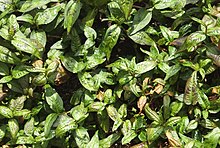Persicaria odorata
| Vietnamese coriander | |
|---|---|

| |
| Scientific classification | |
| Kingdom: | Plantae |
| Clade: | Tracheophytes |
| Clade: | Angiosperms |
| Clade: | Eudicots |
| Order: | Caryophyllales |
| Family: | Polygonaceae |
| Genus: | Persicaria |
| Species: | P. odorata
|
| Binomial name | |
| Persicaria odorata | |
| Synonyms[1] | |
|
Polygonum odoratum Lour. 1790 | |
Persicaria odorata, known as rau răm or Vietnamese coriander, is a herb whose leaves are used in Southeast Asian cooking. Other names for this herb include Vietnamese mint, Vietnamese cilantro, hot mint, laksa leaf, and praew leaf.
Vietnamese coriander is not related to the mints, nor is it in the mint family Lamiaceae, but its general appearance and fragrance are reminiscent of them. Persicaria is in the family Polygonaceae, collectively known as "smartweeds" or "pinkweeds".
Food uses
Above all, the leaf is identified with Vietnamese cuisine,[2] where it is commonly eaten fresh in salads (including chicken salad) and in raw gỏi cuốn, as well as in some soups such as canh chua and bún thang, and stews, such as fish kho tộ. It is also popularly eaten with hột vịt lộn (fertilized duck egg).[3]
In the cuisine of Cambodia, the leaf is known as chi krasang tomhom (ជីរក្រសាំងទំហំ) and is used in soups, stews, salads, and the Cambodian summer rolls, naem (ណែម).
In Singapore and Malaysia, the shredded leaf is an essential ingredient of laksa, a spicy noodle soup, so much so that the Malay name daun kesum means "kesum leaf". In Malaysia the leaf is also used for the dishes nasi kerabu and asam pedas.
In Laos and certain parts of Thailand, the leaf is eaten with raw beef larb (Template:Lang-lo).
In Australia, the plant is being investigated as a source of essential oil (kesom oil).[4]
Characteristics
The Vietnamese coriander is a perennial plant that grows best in tropical and subtropical zones in warm and damp conditions. In advantageous conditions, it can grow up to 15–30 cm (5.9–11.8 in). The top of its leaf is dark green, with chestnut-colored spots, while the leaf's bottom is burgundy red. The stem is jointed at each leaf. In Vietnam, it can be cultivated or found in the wild. It can grow very well outside in summer in nontropical Europe. It prefers full sun and well-drained soil. For colder climate zones, they should be brought inside for the winter and treated as a house plant. For climate zones that have milder winters, they will survive outside, although their growth may slow down. It rarely flowers outside the tropics.
Components
Its oil contains aldehydes such as decanal (28%), and the alcohols dodecanol (44%) and decanol (11%). Sesquiterpenes such as α-humulene and β-caryophyllene comprise about 15% of its oil.[4]
C-Methylated homoisoflavanones (3-(4'-methoxy-benzyl)-5,7-dihydroxy-6-methyl-8-methoxy-chroman-4-one, 3-(4'-methoxy-benzyl)-5,7-dihydroxy-6,8-dimethyl-chroman-4-one, 3-(4'-hydroxy-benzyl)-5,7-dihydroxy-6,8-dimethyl-chroman-4-one, 3-(4'-hydroxy-benzyl)-5,7-dihydroxy-6-methyl-8-methoxy-chroman-4-one and 3-(4'-hydroxy-benzyl)-5,7-dihydroxy-6-methyl-chroman-4-one) can be found in the rhizomes of P. odoratum.[5]
Traditional uses
No scientific studies have measured P. odorata's effects on libido. Traditionally, in Vietnam, the herb is believed to repress sexual urges. A saying in Vietnamese states, "rau răm, giá sống" ("Vietnamese coriander, raw bean sprouts"), which refers to the common belief that Vietnamese coriander reduces sexual desire, while bean sprouts have the opposite effect. Many Buddhist monks grow coriander in their private gardens and eat it frequently, believing it helps them remain celibate.[6]
References
- ^ Tropicos, Persicaria odorata (Lour.) Soják
- ^ Heavenly Fragrance: Cooking with Aromatic Asian Herbs, Fruits, Spices and Seasonings, p.29, Carol Selva Rajah, Tuttle Publishing, 2008
- ^ "Vietnamese Coriander". Monday, 8 July 2019
- ^ a b Kesom Oil – a New Essential Oil for the International Flavour and Fragrance Industry in First Australian New Crops Conference 1996 – Volume 2 Archived 2006-09-19 at the Wayback Machine
- ^ A new C-methylated homoisoflavanone and triterpenoid from the rhizomes of Polygonatum odoratum. Wang D, Li D, Zhu W and Peng P, Natural Product Research, 2009, 23:6, pages 580-589, PMID 19384735
- ^ Vietnamese Coriander (Persicaria odorata (Lour.) Soják) page from Gernot Katzer's Spice Pages
